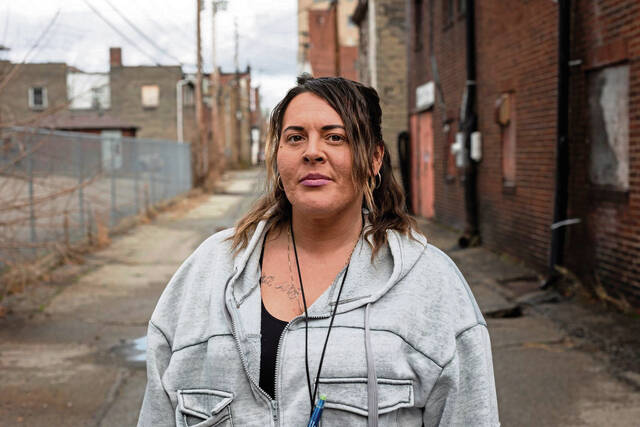Fentanyl arrived right on time for Stephanie Taylor.
“My tolerance was so high, it was taking more and more (heroin) to get my fix, to get me to that feel-good feeling I was searching for,” she said.
Taylor, 35, a Vandergrift native who today is more than four years into recovery, says she was snorting heroin when fentanyl hit the streets. She was the last of her friends to go to the needle, something she attributes to childhood memories of eating cereal with burned spoons her late father had used for injecting heroin.
A dealer introduced Taylor to fentanyl, and she loved it.
“It only took two bags to get you that feeling instead of five bags (of heroin),” said Taylor, who now lives in New Kensington. “It was just handed to me. I experienced it and then it was like, when I called, ‘I want the fentanyl, I want the fentanyl.’ ”
Then people started dying.
“I started knowing friends that I got high with that were overdosing and died. The drug dealers would call me and say return that batch, people were dying. I would say, ‘Oh, no, we’re going to keep this,’ ” she said. “It’s insane to think an addict wants the same stuff that is killing people.
“But when you’re locked up and loaded and gripped in that — we call it using against self will — it’s like, I have no control. I will do anything to get that so I’m not sick.”
Leading cause of fatal overdoses
Synthetic opioids such as fentanyl are the primary cause of overdose deaths in the United States, according to the Centers for Disease Control and Prevention. That’s also true in Pennsylvania and the Pittsburgh region.
Fentanyl contributed to death in 78% of all fatal drug overdoses in Pennsylvania in 2022, according to the state Department of Health’s 2022 annual report on fatal and nonfatal drug overdoses.
Pennsylvania had 5,146 drug overdose deaths in 2022 — 14 per day, on average. That was down 4% from 2021.
In Allegheny County, overdose deaths involving fentanyl surged from 3% in 2013 to a high of 86% in 2020. The number stood at 85% in 2023, according to preliminary data.
In 2022, Allegheny County was among 19 of the state’s 67 counties with overdose death rates from any drug higher than the state average. The county’s overdose death rate was 5.6 per 10,000 people; the state’s was 3.96 per 10,000.
It’s similar in Westmoreland County, where fentanyl accounted for 67 of the 82 overdose deaths (82%) in 2023, according to the county coroner’s office.
When fentanyl first ballooned about nine years ago, it was being used in small amounts to improve the “quality” of other drugs, such as heroin, that dealers had combined with other substances to increase the amount they had to sell, said Tony Marcocci, a detective with the Westmoreland County District Attorney’s Office. Marcocci has spent much of his career investigating drug offenses and was an undercover detective on drug investigations.
In 2015, 56 of 126 drug and alcohol overdoses involved heroin, the Westmoreland County Coroner’s Office said in its annual report. In 27% of heroin-related deaths, the heroin was found to have been adulterated with fentanyl.
Over time, the amounts of fentanyl in heroin increased, Marcocci said.
“It’s almost all fentanyl now,” Marcocci said. “It’s not only increased, but they’re adding more and more to the heroin to the point we’re not even seeing much real heroin anymore.”
Making matters worse now is that dealers are mixing in xylazine, an animal tranquilizer, with fentanyl because it’s supposed to prolong the high, he said.
“The problem is, when people are overdosing because of the fentanyl and they get narcanned, the Narcan is ineffective,” Marcocci said.
Compared to all the other drugs, Taylor said, fentanyl was a cheaper, quicker, stronger and faster high. Her last overdose, on fentanyl, was in 2019 after she had been in rehab for six or seven months. She was living with her mother, who found her unconscious on the floor.
Taylor lost three friends to fentanyl overdoses.
According to the Drug Enforcement Administration, just 2 milligrams of fentanyl, which can fit on the tip of a pencil, can be enough to kill an average person.
“I wish I could tell you how I didn’t die,” Taylor said.
An important tool for treating acute pain
Fentanyl is about 100 times more potent than morphine, according to the Drug Enforcement Administration.
“It has a far greater potency than other opioids,” said Julia D’Alo, chief medical officer of Gateway Rehab, based in Beaver County.
Dr. Anthony Pizon, chief of medical toxicology in UPMC’s Department of Emergency Medicine, said medical uses for fentanyl include treatment of acute pain, such as a broken arm or an emergency surgical procedure, because of its short-term but potent effects.
It also can provide comfort to those at the end of life, D’Alo said.
“The fentanyl used in a hospital is made in a highly regulated way. We know how to properly dose that fentanyl,” D’Alo said. “It’s very important to have as a tool to treat pain for when it’s indicated. It’s safe because you know how to dose it.”
A typical medical dose of fentanyl is measured in micrograms. By comparison, morphine is dosed by the milligram, which is 1,000 times larger than a microgram.
“Like a lot of opioids, it can give you this euphoria,” Pizon said.
That was something Taylor did not want to feel again. After recent gall bladder surgery, which required a 10-inch incision, she declined all opiates and instead relied on ibuprofen.
Taylor was grateful doctors respected her choice.
“I didn’t want to turn on the monster. I know who I can become,” she said. “I didn’t want that feeling. I would much rather go through a little bit of physical pain than to turn that on.”
When patients are administered an emergency dose of fentanyl, they can’t feel the euphoric sensation it triggers. Instead, Pizon said, they start noticing all of the good feelings post-release, which can lead to addiction in the same way other medically prescribed opioids can.
Addiction symptoms of fentanyl are more intense than those associated with heroin, which is why, after frequent usage, people can’t stop.
Because fentanyl is more potent, “the withdrawal is more severe,” Pizon said.
‘Nobody is safe’
Ashley Nicole Morabito died from an overdose in June 2018. She was 24.
Her mother, Debbie Morabito, believes drug addiction and fentanyl poisoning too often go hand in hand.
“Nobody is safe from it,” Debbie Morabito said. “A lot of people experiment with drugs to alleviate anything from pain to mental health problems, like anxiety or depression.
“There’s a lot of fantastic people who have a drug addiction problem and try their hardest to overcome it.”
Before she died, Ashley had gone to college and earned an associate degree in medical billing and coding. She was doing an externship for UPMC in Murrysville but died less than a month before she was scheduled to graduate with honors.
An avid swimmer, she was on the Kiski Area High School swim team and was a lifeguard. A cheerleader during high school, she was into fashion and cosmetics and had done modeling.
Ashley’s father, Jamie Morabito, thinks back on how much of an upbeat and caring person his daughter was. She was a successful student and a kind-hearted person, he said.
“My daughter was a wonderful young lady,” Jamie Morabito said. “I light a candle every week for Ashley in church. I have since the day she passed away. And I talk to her every day.”
‘Everything is fentanyl’
Since they are always looking for the next high, addicts often will take a drug without asking where it came from, measuring it or confirming its contents.
Most people who say they’re using other drugs such as heroin, Percocet, Xanax or benzodiazepines test negative for those substances and instead test positive for fentanyl, D’Alo said.
“Honestly, we don’t see heroin really ever anymore,” Pizon said. “Everything is fentanyl or fentanyl derivatives.”
Someone who thinks they are snorting cocaine could have no idea it also contains fentanyl and inadvertently overdose, she said. A person who takes fentanyl without a built-up tolerance, whether a first time or in a relapse, is at increased risk of death.
“People trust their friends, and their friend might not even know that fentanyl is in something that they’re giving to somebody,” Debbie Morabito said.
Where it comes from
The leading producers of illicit fentanyl are based in Mexico and China, where the drug is made from simple recipes using obtainable and cheap precursor chemicals, according to the Drug Enforcement Administration. The final product often is smuggled into the United States.
“The fentanyl that’s on the streets is illicitly manufactured, and it’s not controlled,” D’Alo said. “People who use drugs and are buying fentanyl don’t know what they’re getting.”
Once it gets into the hands of dealers, fentanyl often is mixed with other illicit drugs and sold as powders, nasal sprays or pressed pills, making them look like legitimate prescription opioids.
In its “One Pill Can Kill” campaign, the DEA shows how it’s impossible to tell a fake pill — oxycodone, Xanax or Adderall, for example — from legitimate ones, D’Alo said.
In 2023, the DEA says it seized more than 75.6 million fentanyl pills and 11.5 million pounds of powder. Seven out of every 10 pills seized by the DEA contained lethal doses of fentanyl.
“That’s why it’s so unsafe to buy on the street,” D’Alo said. “You literally have no idea what you’re getting.”
Although she has been out of the street life for a while, Taylor counsels active and recovering addicts as a recovery coach at Lost Dreams Awakening in New Kensington. Pressed pills are what she sees now.
“People think they’re getting oxycontins, but they’re pressed pills, which means they’re full of fentanyl,” she said. “It just changed the form.”
Taylor’s addiction included pain pills, which she and those around her got from doctors and clinics in Pennsylvania and Florida until they were shut down.
The sharp increase in fentanyl deaths since 2013 occurred as it became more difficult to get prescription opioids, D’Alo said.
“Prescribers had to be more careful prescribing opioids to patients,” she said. “Many people turned to the streets to get their opioids. Fentanyl came into the picture, which made things worse.”
Today, people who use drugs are frightened of fentanyl, D’Alo said.
“They have experienced a lot of loss of life around them,” she said. “They have lost a lot of their friends and family to overdoses. A lot of times, that is driving people to want to enter into recovery, the sheer destruction of what fentanyl has done in and around them.”
Taylor is seeing more advocacy, and it’s talked about more.
“There’s been so much pain regarding addiction from fentanyl that has touched lives of everyone,” she said. “It could happen to anyone. It’s affecting families so much that how can you not talk about it.”
Brian C. Rittmeyer is a TribLive reporter covering news in New Kensington, Arnold and Plum. A Pittsburgh native and graduate of Penn State University, Brian has been with the Trib since December 2000. He can be reached at brittmeyer@triblive.com.













